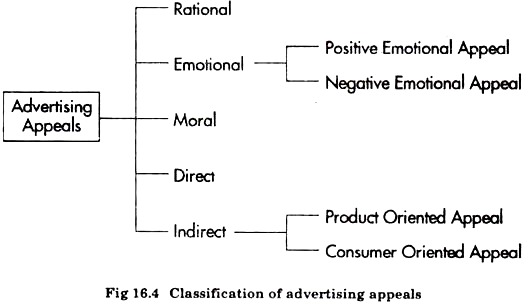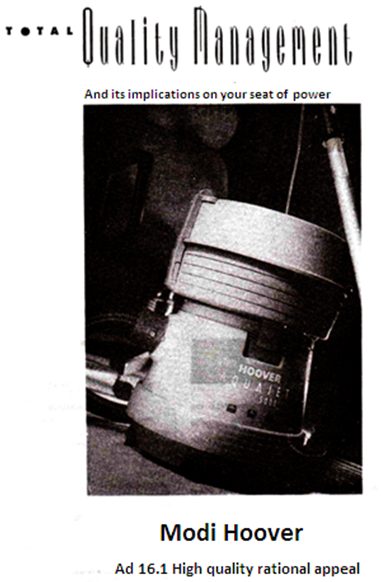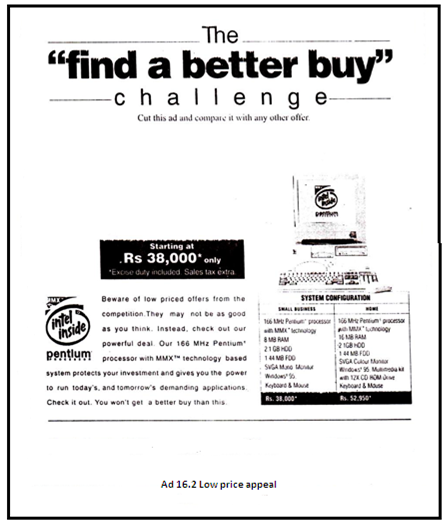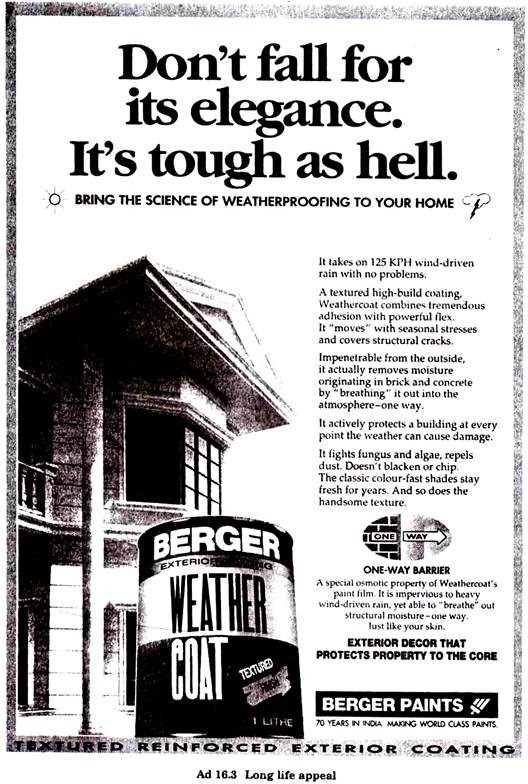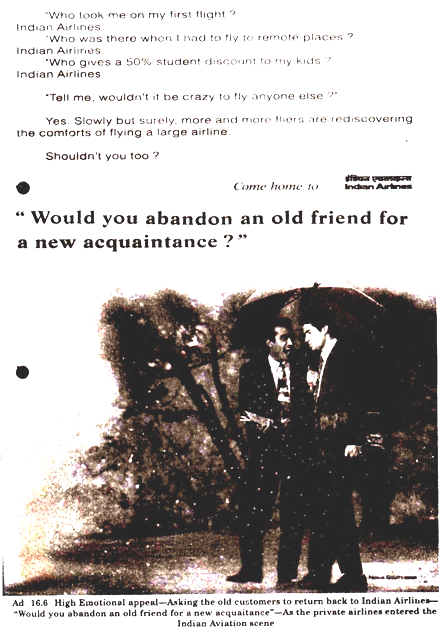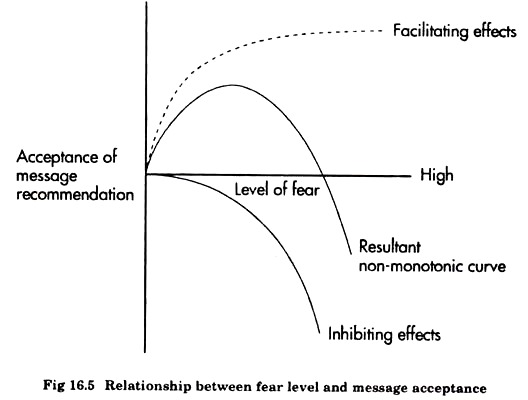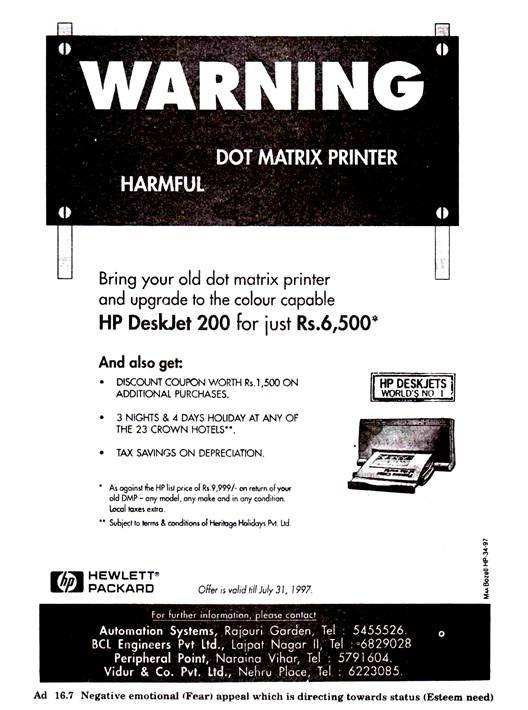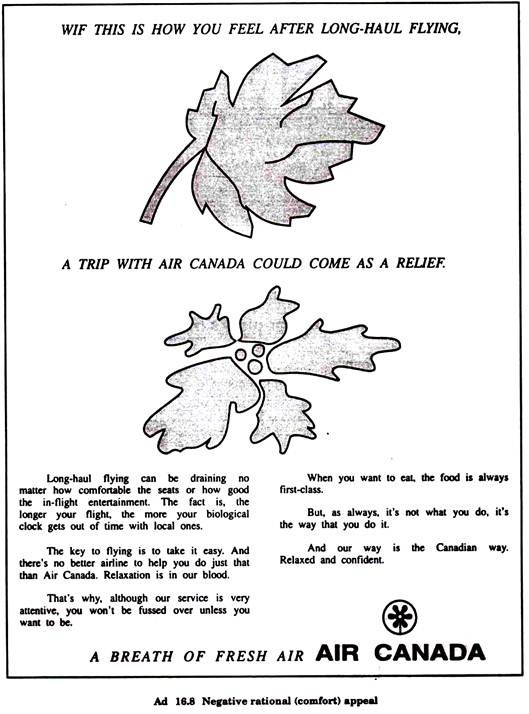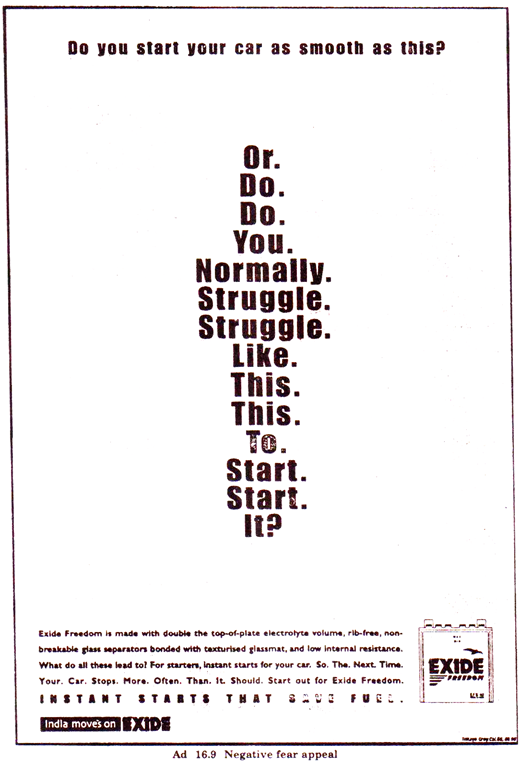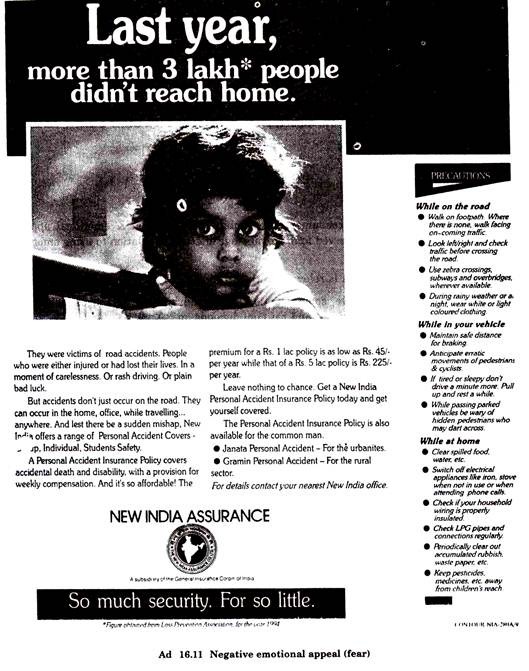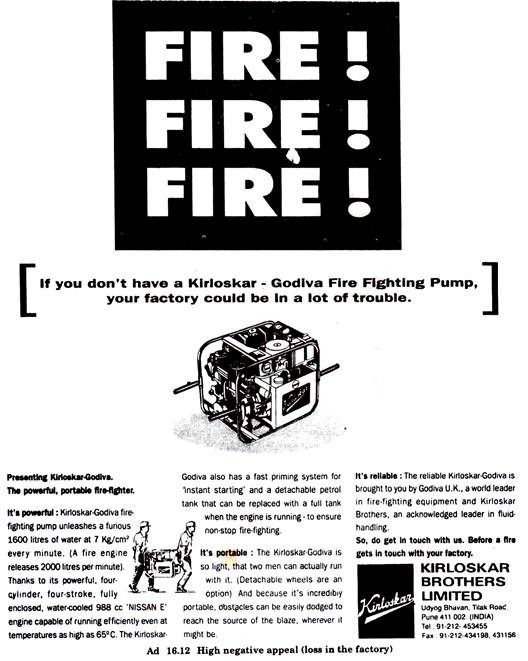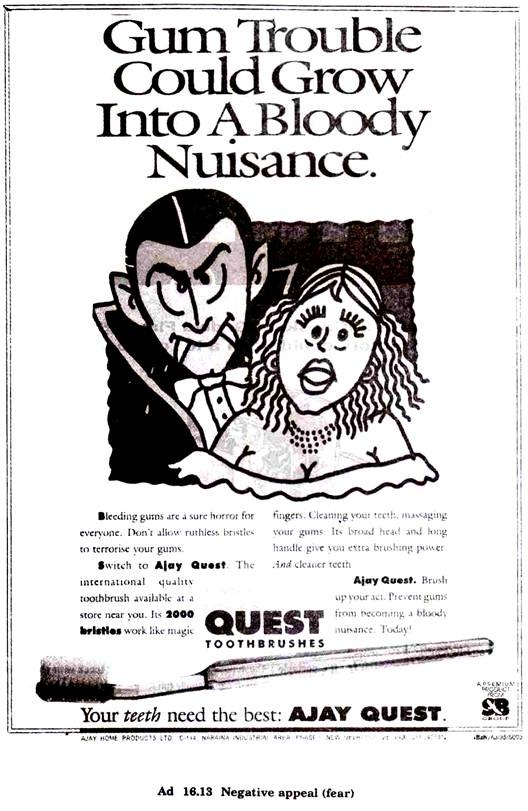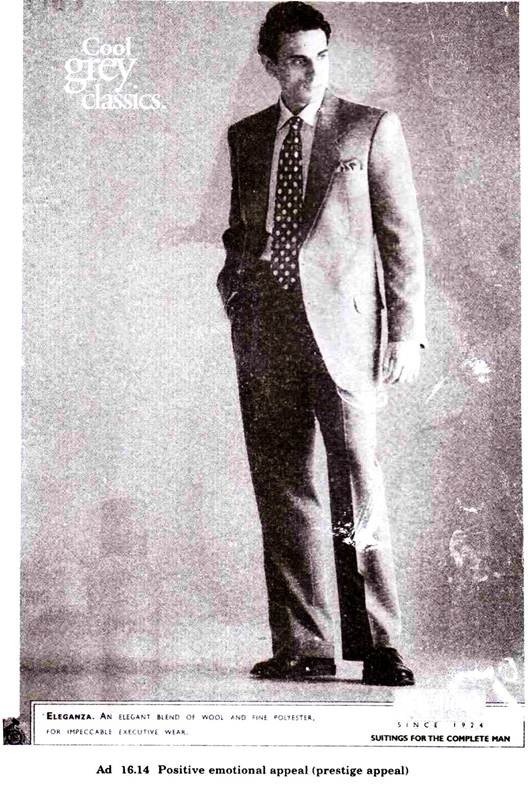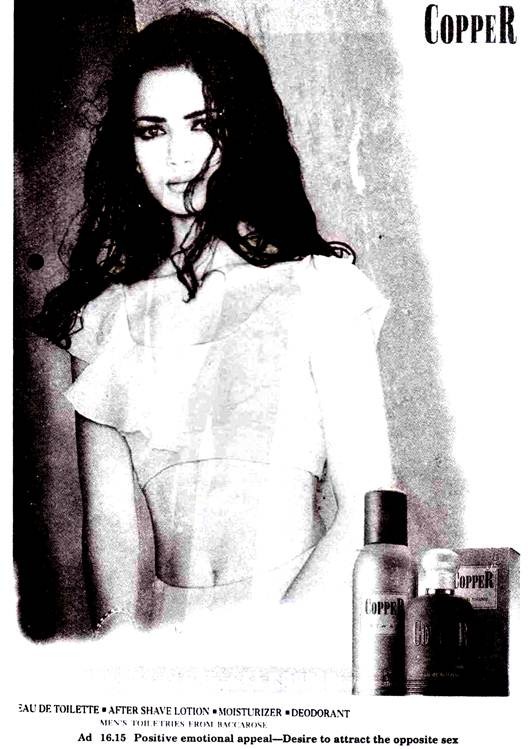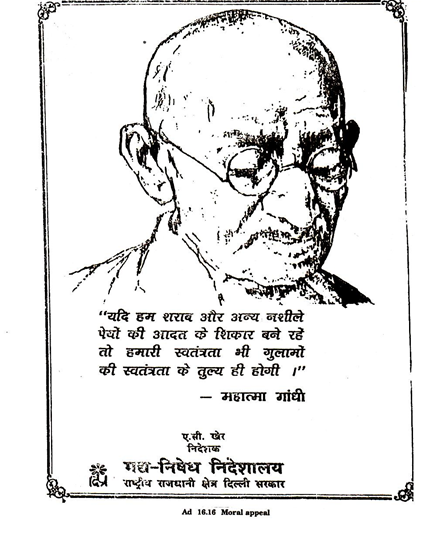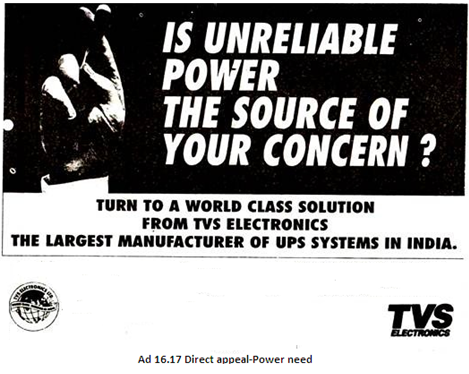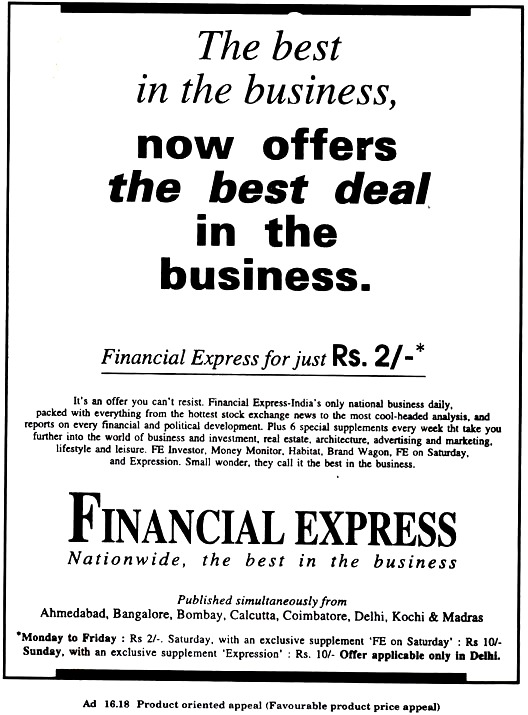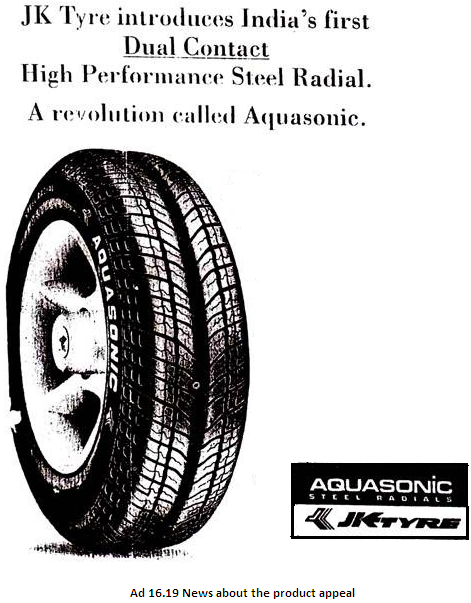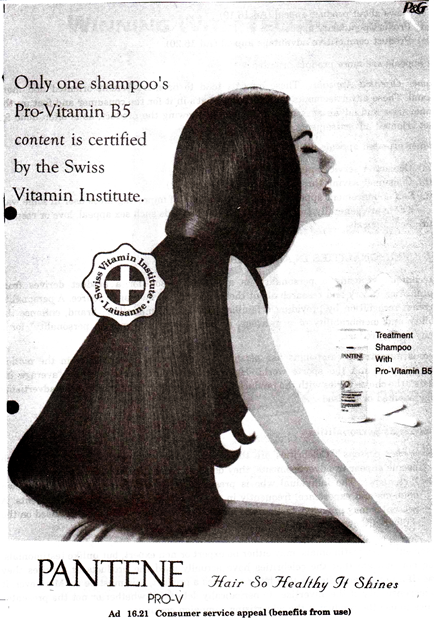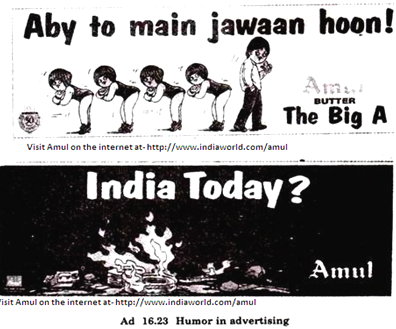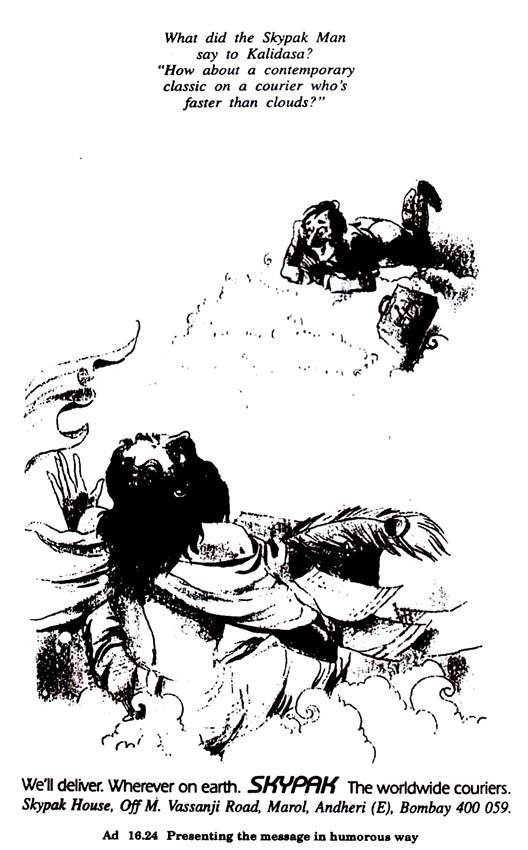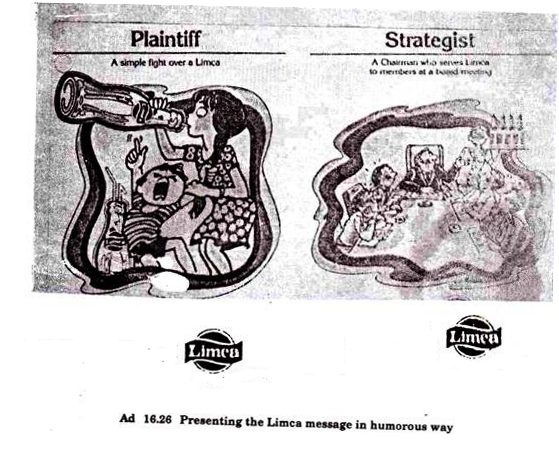This article guides you about how to make your advertisement much more appealing.
Advertising Appeals:
Appeals are cues that provide stimulus. Appeals are developed on the basis of buying motives, advertising message should appeal directly or indirectly to those key needs which influence behaviour. Advertising message is. developed in term of its contents by using an appeal or an idea or an unique selling preposition.
Appeals are broadly classified as follows: (Fig. 16.4):
Rational Appeals:
Here the functional benefits of a product is highlighted. Industrial buyers are most responsive to rational appeals.
Buying motives are normally considered rational under the following circumstances:
(i) High quality appeal (Ad. 16.1)
(ii) Low price appeal (Ad. 16.2)
(iii) Long life appeal (Ad. 16.3)
(iv) Performance minted appeal (16.5)
(v) Ease to use oriented appeal
(vi) Resale value oriented appeal
(vii) Economy in operating expenses oriented appeal (Ad. 16.5)
Rational appeals are generally product oriented appeals.
Emotional Appeals:
Emotional appeals are those appeals which an not preceded by careful analysis of proms and cons of making a buying decision. Emotions are those mental agitations or excited states of feeling which prompt up to make a purchase. Emotional motives may be below the consciousness, and may not be recognised by person.
Emotional appeals are designed to stir up some negative or positive emotions which will motivate product interest. Through the Motivation Research studies, it has been found that negative emotional appeals are more effective than positive one.
Negative Emotional Appeals:
1. An advertiser may try to induce a particular behavioural change by emphasizing either positive or negative appeals or a combination of both.
2. Fear appeal in the most important among emotional appeals and also the most effective.
3. Positive appeal use the strategy of reducing a person’s anxiety about buying and using a product while negative appeals use the strategy of increasing a person’s anxiety about not using a product.
4. Positive appeal stresses the positive gains to a person from complying with the persuasive message while negative appeal stresses his loss if he fails to comply.
5. Fear appeal is used in a wide variety of product categories when products are designed to protect an individual from some loss of health (Medical or life insurance), protect an individual from loss of property (automobile or home).
6. Fear appeals are at time used in ad messages in connection with getting people to stop doing the things they should not do. (ad relating to prohibition, prevention of losses and conservation of energy).
7. There are many products/services which are directly or indirectly involved in the avoidance of a fearful situation.
8. Fear appeal may be in the form of loss of status, friendship, job, position [e.g., personal care products like soaps, cosmetics, deodorants, shave lotions, mouth wash etc.].
9. The more carefully fear is built, the greater is the tension resulting in a greater drive to reduce the tension.
10. Research studies have shown that great fear appeals are less effective than moderate ones.
How fear work:
Before deciding to use a fear appeal based message strategy, the advertiser should consider how fear operates, what level to use, and how different target audiences may respond. One theory suggests that the relationship between the level of fear in a message and acceptance or persuation is curvilinear, as shown in Fig. 16.5 this means that message acceptance increases as the amount of fear used rises.
This increase in message acceptance does not continue. However, beyond a certain point, acceptance decreases as the level of fear rises.
This relationship between fear and persuation can be explained by the fact that fear appeals have both facilitating and inhibiting effects. A low level of fear can have facilitating effects; it attracts attention and interest in the message and may motivate the receiver to act to resolve a threat. Thus, increasing the level of fear in a message from low to moderate can result in increased persuation.
High levels of fear, however, can produce inhibiting effects. The receiver may emotionally block the message by tuning it out, perceiving it selectively, or denying its arguments out right Fig. 16.5 illustrates how these two counter effects operate to produce the curvilinear relationship between fear and persuation.
Recently an alternative approach to the curvilinear explanation of fear has been offered—the protect. motivation model.
According to this theory, for cognitive appraisal processes mediate the individual’s response to the threat; appraising 1) the information available regarding the severity of the perceived threat, 2) the perceived probability the threat will occur, 3) the perceived ability of a copying behaviour or remove the threat, and 4) the individual’s perceived ability to carry out the copying behaviour.
This model suggests that both the cognitive appraisal of the information in a fear appeal message and the emotional response mediate persuation. An audience is more likely to continue processing threat related information, which increases the likelihood that a coping behaviour will occur.
The protection motivation model suggests that ads using fear appeals should give a target audience information about the severity of the threat, the probability of its occurrence, the effectiveness of a coping response, and the case with which the response can be implemented.
For example, ads for ‘American Express Travelers Cheques’ show how easily a vacation can be ruined if you lose all your cash. They reduce the anxiety by offering a solution to the problem—using the company’s travelers cheque and getting an immediate refund if they are lost or stolen.
It is also important to consider how the target audience may respond to fear appeals. Fear appeals are more effective when message recipient is self-confident and prefers to cope with dangers rather than avoid them. They are also more effective among non-users of a product than among users. Thus, a fear appeal may be more useful in keeping non-smokers from starting smoking than persuading smokers to stop smoking.
Positive Emotional Appeal:
It highlights product benefits and attributes capable of influencing consumer behaviour. These appeals include the appeal for love, humor, pride, prestige and joy.
Other positive emotional appeals include:
(a) Desire to be different
(b) Desire to conform
(c) Desire to attract the opposite sex
(d) Desire for prestige.
While making purchases, the consumer may combine both rational & emotional appeals. Following principles can be observed to make message effective in relation to using emotional & rational appeals:
If emotions are used, be sure it is relevant to the strategy.
All advertising messages have some emotion. Some advertising messages are totally emotional.
The balance of emotional and rational depends on:
1. How familiar our message is?—More familiarity leads to more emotion.
2. The importance of what you have to say—more importance leads to more rationality.
3. The number of times the consumer will be exposed to our message—more repetition allows to form emotion.
Television is better at conveying emotion; print is better at rational argument. This difference is due to the pace of presentation, the control given to the receiver, and the ability to convey emotion using sight, sound and motion.
It is harder to put emotion into a still picture or a set of wards. As a result, many products split the two and use television to show emotion and then justify things with a rational print campaign. To try to do everything in one medium can easily lead to failure. There was time when many television commercials had an emotional video track with a rational audio track. It didn’t work.
A strong emotional element is most relevant in certain (following) situations:
1. To add interest when there is nothing to say.
2. To suggest superiority in a subjective area.
3. To create a difference when the benefit is generic.
4. When there is nothing of importance to say.
5. There is no advertising situation where the inclusion of strong relevant emotional appeals will not be beneficial.
6. To provide continuity across messages in a campaign.
The rational appeal in advertising is always important. One should seldom depend entirely on emotion. Although many decisions are made for emotional reasons, people need a rational one to justify their emotions.
Buying an expensive luxury car is an emotional decision but print ads in this product class also give rational information so that buyers can justify their decisions in terms of convenience, balance, brakes, leg room, trunk space and fuel economy.
Moral Appeals:
Moral appeals are those appeals to the audience which appeal to their sense of right and wrong. These are often used in messages to arouse a favourable response to social causes such as prohibition, adult literacy, social forestry, anti-smuggling, consumer protection, equal rights for women, rural development etc.
Besides the above discussed appeals another classification of appeal divides the advertising appeals into two broad categories:
(a) Direct advertising appeal
(b) Indirect advertising appeal.
(a) Direct Advertising Appeal:
Direct advertising appeals are those appeals that clearly communicate with the consumers about a given need followed by a message which extols the advertised brand which satisfy the need.
(b) Indirect Advertising Appeal:
Indirect advertising appeals are those appeals which do not emphasize a human need, but allude to a need. As advertisers understand the influence of needs upon selective perception, they leave some ambiguity in the message so that the consumers may be free to interpret it and the need to which the advertiser is appealing.
Product Oriented:
1. Feature oriented appeals
2. Use oriented appeals
3. Product Comparison
Consumer Oriented:
1. Attitude oriented appeals
2. Significant group oriented appeal
3. Life style oriented appeal
4. Image oriented appeal
5. Sub conscious oriented appeal
Product Oriented Appeals:
Product oriented appeals tend to be more rational or of informative nature and focus on the attributes of the brand.
A product oriented appeals include:
(a) Product feature appeal
(b) Favourable product price appeal (Ad 16.18)
(c) News about product appeal (Ad 16.19)
(d) Product popularity appeal
(e) Product competitive advantage appeal (Ad 16.20). These appeals are more product oriented.
Consumer Oriented Appeals:
These appeals tend to be more benefit oriented and more emotional. These advertisements tend to show what’s in it for the consumer and feature the consumer uses and advantages more than merely showing the product, as is often done for product oriented advertisements.
Consumer oriented appeals include:
(a) Consumer service appeals (Ad 16.21)
(b) Consumer saving through use appeals (Ad 16.22)
(c) Self enhancement appeals—present the benefit of improving these user in some way. These are generally emotional ads offering rewards such sex appeal, love or respect.
(d) Fear appeals.
Use of Personalities in Advertising:
The technique of using a personality as a spokes person for a product derives from communication theory and research about the importance of message’s source. A personality may create recognition by providing a familiar face for an unfamiliar brand, enhance the credibility and memorability of a message, or even create a “symbolic personality” for a company or its product.
Numerous advertising campaigns use personalities, generally celebrities from the motion picture industry and the sports world. However, personalities can also be “average individuals”, the choice varies with the product advertised and/or the marketing and advertising strategy adopted or devised.
Celebrities as Personalities:
1. Spokes persons:
Celebrities are those people who are widely known. When such people appear in advertisements, they do so as presenters or spokes persons.
2. Presenters:
The individual who is presenter of a product usually offers his own opinions and experience, frequently in the form of testimonials or endorsements. A presenter may provide a testimonial about the excellence of the product based on the individual’s own personal experience.
Endorsements, like testimonials, may either be expert or non expert, but unlike testimonials, they do not indicate that the celebrities have actually used the products or services they endorse. If a presenter indicates that he or she uses a product, this must be so. Moreover, it is the responsibility of the advertiser to periodically determine whether or not the presenter continues to use the product if the advertising campaign continues.
Spokes Persons:
A spokes person does not endorse the product; rather, the personality speaks for the company. Individuals selected as spokes persons are usually high in status and have wide spread acceptance because they are frequently used for corporate or image advertising campaigns.
Selecting a Celebrity:
In selecting celebrity as the personality of an ad campaign, a number of criteria are used.
1. Compatibility of the individual with the product:
A product that is designed to project an image may find that image can be enhanced by a particular type of celebrity. Male celebrities, particularly those who represent a ‘Macho’ character, offer the appropriate image for men’s toiletries.
2. Acceptance of the individual by the target audience:
A number of characteristics are presumed to make personalities acceptable to the public. These include the attributes of popularity, credibility, and sincerity. Popular sports figures are frequently used as celebrity and spokes person, but this may vary with the perceptions of the target audience about the sport itself.
As a general rule of thumb, As cricket reaches a variety of age and income groups, is considered a middle – income game, golf and tennis are sports for upper income people, and basket ball is popular among those 18 to 35. Some sports figures, however, are accepted by consumers in any situation.
Non-celebrities as Personalities:
It is not always necessary to use a celebrity. While celebrities have greater popularity, at least initially, the characteristics of sincerity and credibility are sometimes more likely to emerge from an “average individual”. As surf excel (HLL), Whisper (P & G) used a common house lady as a endorser.
Using non celebrities in ad campaign offers both advantages and disadvantages. While it is clear that celebrities usually give more professional performances, amateurs in ads may, in fact, provide new expressions, interesting in nuendos, and crisper presentations.
Nonetheless, consumers may distrust real people, believing that those who appear in ads have been coached to say what they do and in fact, are professional actors. Further more, if such spokespersons are too unattractive, they may call more attention to themselves than to the product. Finally when average consumers are told before endorsing a product that they will receive payment or will appear on television as compensation, viewers of the ad must be informed. Such disclosure is not required when celebrities are endorsers.
Essentials of a Sound Advertising Appeal:
1. It must be thematically sound & complete
2. It must be communicative & interesting.
3. It must have credibility.
Humor in Advertising (Humor Appeal):
Humorous advertisements are often the best known and best remembered of all advertising messages. Advertisers use humor for many reasons. Humorous messages attract and hold consumer’s attention.
The enhance effectiveness by putting consumers in a positive mood, increasing their liking of the advertising itself and their feeling towards the product or service. And humor can act as a distraction, reducing the likelihood that the receiver will counter argue against the message.
Critics argue that funny advertising’s draw people to the humorous situation but distract them from the brand and its attributes. Also effective humor can be difficult to produce and some attempts are too subtle for mass audiences.
Limca today is claimed by Parle’s as the top selling soft drink. Like wise, Skypak have become India’s largest courier. Amul is the largest Indian enterprise in powdered milk and gives a tough fight to cadbury’s in chocolates. Wills filter is the largest selling filter cigarette in its class.
Tortoise mosquito coils are the top selling brands in its class. Zero-B has become the best known product in Indian cities. Pepsi namkin has become the household name. And all of them have not shied from using humour in their advertising.
Clearly, there are valid reasons both for and against the use of humor in advertising. Not every product or service lends itself to a humorous approach. An interesting study surveyed the research and creative directors of the top 150 advertising agencies.
They were asked questions regarding which communications objectives are facilitated through the use of humor and the appropriate situational use of humor in terms of media, product, and audience factors.
The general conclusions of this study are:
1. Humor does aid awareness and attention.
2. Humor may harm recall and comprehension in general.
3. Humor may aid name and simple copy registration.
4. Humor may harm complex copy registration.
5. Humor may aid retention.
6. Pursuasion in general is not aided by humor.
7. Humor may aid persuation to switch brands.
8. Humor creates a positive mood that enhances persuasion.
9. Source credibility is not aided by humor.
10. Humor is not generally very effective in bringing about action/sales.
11. Creatives are more positive on the use of humor to fulfill all the above objectives than the research directors.
12. Radio and TV are the best media in which to use humor, where as direct mail and newspaper are least suited.
13. Consumer nondurables and business services are best suited to humor, where as corporate advertising and industrial products are least suited.
14. Humor should be related to the product.
15. Humor should not be used with sensitive goods or services.
16. Audiences that are younger, better educated, up scale, male, and professional are best suited to humor, Older, less educated, and down scale groups are least suited to humor appeals.
